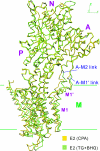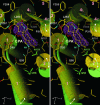Interdomain communication in calcium pump as revealed in the crystal structures with transmembrane inhibitors
- PMID: 17389383
- PMCID: PMC1851572
- DOI: 10.1073/pnas.0700979104
Interdomain communication in calcium pump as revealed in the crystal structures with transmembrane inhibitors
Abstract
Ca(2+)-ATPase of skeletal muscle sarcoplasmic reticulum is an ATP-driven Ca(2+) pump consisting of three cytoplasmic domains and 10 transmembrane helices. In the absence of Ca(2+), the three cytoplasmic domains gather to form a compact headpiece, but the ATPase is unstable without an inhibitor. Here we describe the crystal structures of Ca(2+)-ATPase in the absence of Ca(2+) stabilized with cyclopiazonic acid alone and in combination with other inhibitors. Cyclopiazonic acid is located in the transmembrane region of the protein near the cytoplasmic surface. The binding site partially overlaps with that of 2,5-di-tert-butyl-1,4-dihydroxybenzene but is separate from that of thapsigargin. The overall structure is significantly different from that stabilized with thapsigargin: The cytoplasmic headpiece is more upright, and the transmembrane helices M1-M4 are rearranged. Cyclopiazonic acid primarily alters the position of the M1' helix and thereby M2 and M4 and then M5. Because M5 is integrated into the phosphorylation domain, the whole cytoplasmic headpiece moves. These structural changes show how an event in the transmembrane domain can be transmitted to the cytoplasmic domain despite flexible links between them. They also reveal that Ca(2+)-ATPase has considerable plasticity even when fixed by a transmembrane inhibitor, presumably to accommodate thermal fluctuations.
Conflict of interest statement
The authors declare no conflict of interest.
Figures






References
-
- Møller JV, Juul B, le Maire M. Biochim Biophys Acta. 1996;1286:1–51. - PubMed
-
- Toyoshima C, Inesi G. Annu Rev Biochem. 2004;73:269–292. - PubMed
-
- Toyoshima C, Nakasako M, Nomura H, Ogawa H. Nature. 2000;405:647–655. - PubMed
-
- Toyoshima C, Nomura H. Nature. 2002;418:605–611. - PubMed
-
- Toyoshima C, Mizutani T. Nature. 2004;430:529–535. - PubMed
Publication types
MeSH terms
Substances
Associated data
- Actions
- Actions
- Actions
- Actions
LinkOut - more resources
Full Text Sources
Miscellaneous

